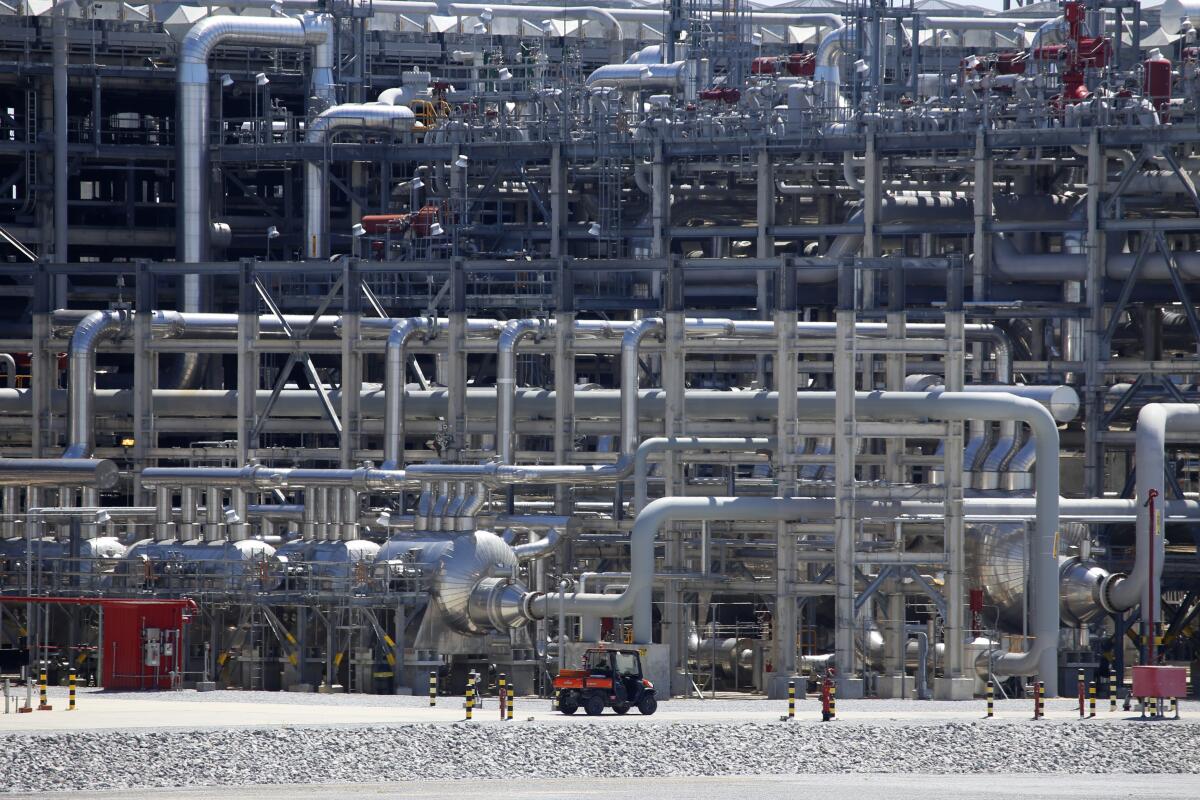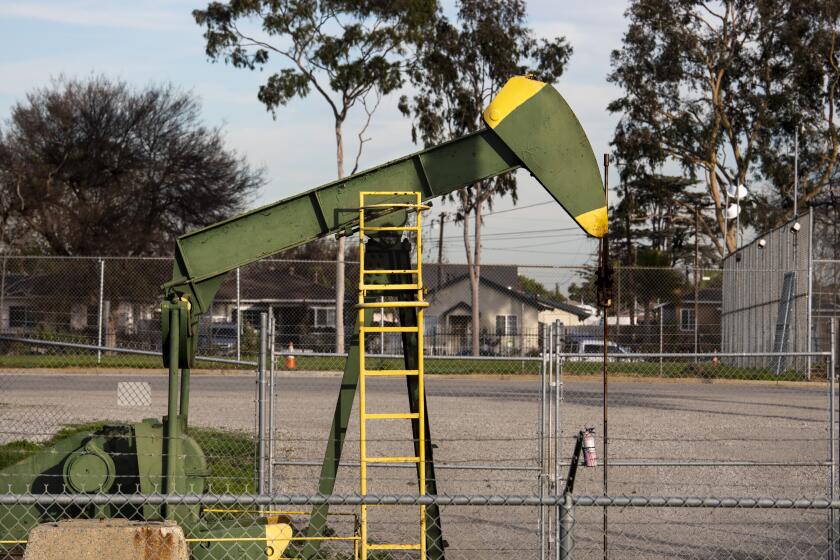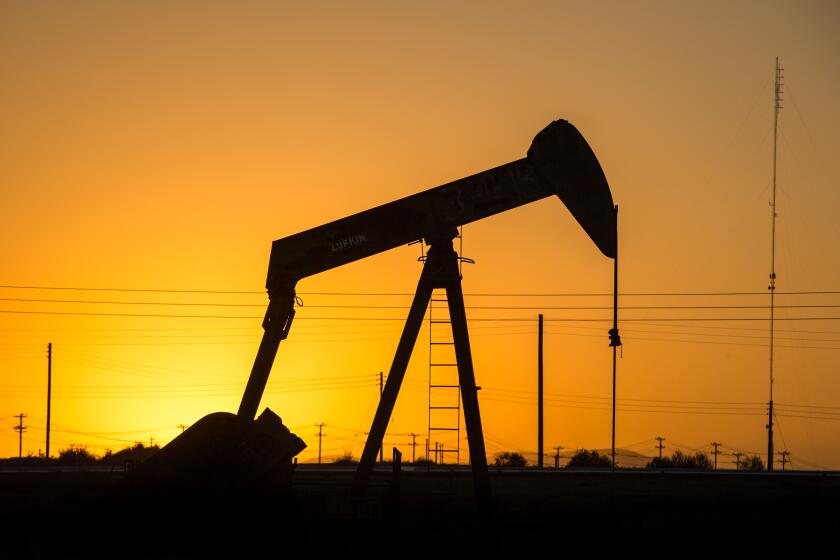To shut down the supply side of climate change, start here

- Share via
September was a scary month — or as one prominent climate scientist termed it, “gobsmackingly bananas.” It broke all temperature records for the month and by a record margin. The Earth busted through — at least temporarily — the 1.5-degree Celsius (2.7-degree Fahrenheit) red line that the nations of the world drew with the Paris accords.
Almost as scary as the temperature, however, has been the reaction — or, more precisely, the lack of it in Washington. But now an enormous opportunity looms for the Biden administration: Its chance to prove to the world that it takes the supply side of the climate challenge as seriously as the demand side.
Having begun to credibly cut demand for fossil fuels by boosting electric vehicles, heat pumps and solar panels with the the Inflation Reduction Act, the White House needs to start turning down the supply by stanching the spiking exports of fossil fuels.
For California to successfully fight climate change, the state’s politicians, business leaders and millions of residents will need to work a lot harder.
The place where that change should begin is along the Louisiana coast, where a massive fossil fuel build-out is underway, with a vast and growing array of export terminals and pipelines. If the oil and gas industry has its way, America will expand its production more than any other country in the next decade (far more than China). LNG gas shipments — LNG stands for “liquefied natural gas” — from the Gulf of Mexico are by far the biggest source of that growth.
One of us grew up in Louisiana and founded the Hip Hop Caucus’ Gulf Coast Renewal Campaign in the years after Hurricane Katrina decimated New Orleans. To anyone who knows this region, the idea of putting new LNG facilities in a place where hurricanes grow ever stronger is ludicrous, and that they are slated mostly for poor communities of color runs counter to the Biden administration’s promise to protect those who have been affected “first and worst” by fossil fuel development.
A referendum to overturn a ban on new oil drilling near homes and schools qualified for the November 2024 ballot. In the meantime, California should deny requests to drill more oil wells in neighborhoods.
The other of us lives a long way from the bayous, in a tiny town in the mountains of northern New England where the fishing is for brook trout, not shrimp and crabs. But that’s the point — on a globally warmed planet, no place is distant from another. That small Vermont town was racked by repeated flooding this summer. And the record rains were the product of a warmed atmosphere caused by greenhouse gas emissions, which are embedded in these new projects.
The scale of those emissions is staggering. Just one proposed new project — the CP2 LNG terminal in Cameron Parish, which may get a green light from the Federal Energy Regulatory Commission as early as this month — will be responsible for 20 times more greenhouse gas emissions annually than the controversial Willow oil drilling project in Alaska that the Biden administration approved earlier this year, much to the dismay of the young environmentalists. If the proposed build-out of LNG Gulf facilities is completed by 2030, the resulting cloud of carbon dioxide and methane would mean the U.S. was producing greenhouse gas emissions comparable to the level in 2005, back when the drive to deal with climate change was just beginning.
State legislators do not have the luxury of taking a year off from fighting the climate crisis and should muster the votes to pass what remains of a three-bill climate accountability package before the end of the session.
The emissions from burning liquefied natural gas won’t be counted against our national total; they will be charged to the countries we export the gas to, which is where it will be burned. But the climate doesn’t care; in the atmosphere, it’s just more carbon and methane. If we produce it, we bear responsibility for it.
The LNG build-out is precisely the kind of fossil fuel expansion the International Energy Agency targeted in 2021 when it said no new fossil fuel infrastructure should be built anywhere on the planet, beginning that year. The LNG companies argue that because burning natural gas produces less carbon than burning coal, it’s a net benefit to frack and export more.
We’ve all been sweltering this summer. But majority Black and brown communities, and low-income communities, are closest to the boiling point.
Unfortunately, the latest data show that methane leaks at fracking sites, in pipelines and at processing plants, added to what is released as gas is burned, make gas as dirty as coal. Besides, the world is no longer committed to marginal, fractional improvement in emissions; net-zero pledges require moving everyone as quickly as possible to cheap renewable energy (as, ironically, Gulf states like Texas have begun to do).
Russia’s invasion of Ukraine gave the natural gas industry an opening it grabbed; the short-term need to get Europe through the first winter of the war allowed LNG companies to build export terminals that will last 40 years, long after Russian leader Vladimir Putin will have disappeared. And the Biden administration approved new plants and terminals that are now in the pipeline. But another doubling of our export capacity can be avoided if facilities like CP2 can be kept offline.
The California governor is expected to visit the country this month. He will find that it’s achieved more on electric vehicles and clean energy than most Americans appreciate.
And happily, blocking CP2 and other new LNG infrastructure is doable. Even if FERC gives final approval for construction to CP2 this month, it and those that follow will still need export licenses from the Department of Energy to make them financially worth building, and that process requires the department to find that operating the facilities is in “the public interest.” At the moment, the standards for that finding are left over from the Trump administration. It would make enormous sense for Biden’s Energy Department to reject the CP2 application, then reevaluate those standards for other proposed plants. Any new LNG facilities will fail a fair “public interest” assessment; they make no sense on a rapidly warming planet.
And they also don’t make economic sense for America. Exporting natural gas drives up its cost for domestic consumers who still rely on it for cooking, heating and cooling, which means that Biden and his Energy secretary, Jennifer M. Granholm, should be able to sell a retreat from the Gulf LNG build-out as a political plus, defending consumers from energy inflation.
Doing anything else would be gobsmackingly bananas.
The Rev. Lennox Yearwood is the president and CEO of the Hip Hop Caucus. Bill McKibben is the founder of Third Act, which organizes people over 60 for action on climate and democracy.
More to Read
A cure for the common opinion
Get thought-provoking perspectives with our weekly newsletter.
You may occasionally receive promotional content from the Los Angeles Times.














